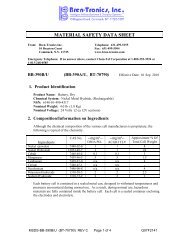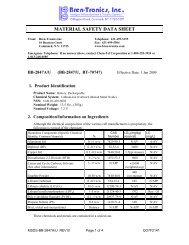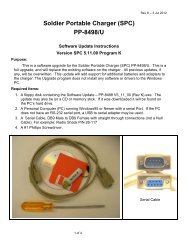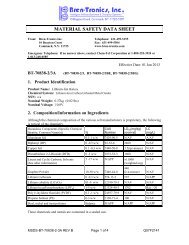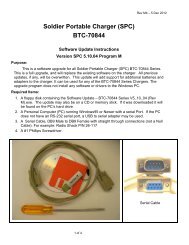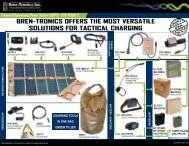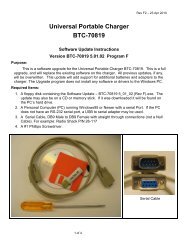MATERIAL SAFETY DATA SHEET - Bren-Tronics Inc.
MATERIAL SAFETY DATA SHEET - Bren-Tronics Inc.
MATERIAL SAFETY DATA SHEET - Bren-Tronics Inc.
- No tags were found...
You also want an ePaper? Increase the reach of your titles
YUMPU automatically turns print PDFs into web optimized ePapers that Google loves.
<strong>MATERIAL</strong> <strong>SAFETY</strong> <strong>DATA</strong> <strong>SHEET</strong>From: <strong>Bren</strong>-<strong>Tronics</strong> <strong>Inc</strong>. Telephone: 631-499-515510 Brayton Court Fax: 631-499-5504Commack, N.Y. 11725www.bren-tronics.comEmergency Telephone: If no answer above, contact Chem-Tel Corporation at 1-800-255-3924 or1-813-248-0585BT-70242 (BT-70242-1, -2, & -3) Effective Date: 01 Mar 20081. Product IdentificationProduct Name: Lithium BatteryChemical System: Lithium – Thionyl Chloride, (Non-Rechargeable)NSN: n/aNominal Weight: 3.5 oz , (100 g)Nominal Voltage: 3.6 V2. Composition/Information on IngredientsRev A n/aRev B 01 May 2009Although the chemical composition of the various cell manufacturers is proprietary, the following istypical of the chemistry.Ingredients CAS No. Content OtherLimits N/ALithium (Li) 7439-93-2 3.5 to 5% --Thionyl Chloride (SOCl2) 7719-09-7 40 to 46% --Aluminum Chloride anhydrous (AlCl3) 7446-70-01 to 5% --Carbon (Cn) 1333-86-43 to 4% --These chemicals and metals are contained in a hermetically sealed can.3. Hazards IdentificationRoutes of Entry:Inhalation?Skin?Ingestion?YesYesYesPotential Health Effects:These chemicals are contained in a sealed can. Risk of exposure occurs only if the batteryis mechanically, thermally, or electrically abused which can then lead to the activation of safetyvalves and/or the rupture of the battery containers. Electrolyte leakage, electrode materialsreaction with moisture/water or battery vent/explosion/fire may follow, depending upon thecircumstances.4. First Aid MeasuresMSDS-BT-70242 REV B Page 1 of 4 Q07F2141
Other:In the event of leakage, wear chemical apron.9. Physical and Chemical PropertiesAppearance: Cylindrical shape.Odor: if leaking, gives off a pungent odor.10. Stability and ReactivityStability:Stable under conditions described in Section 7Conditions to Avoid:DO NOT heat above 100°C or incinerate, Deform, Multilate, Crush, Pierce, Disassembly,Recharge, Short circuit, Expose over a long period to humid conditions.Materials to avoid:Oxidising agents, alkalis, water. Avoid electrolyte contact with aluminum or zinc.Hazardous Decomposition or By-products:Hydrogen (H 2 ) as well as Lithium oxide (Li 2 O) and Lithium hydroxiode (LiOH) dust isproduced in case of reaction of lithium metal with water.Chlorine (CI 2 ), Sulfur dioxide (SO 2 ) and Disulfur dichloride (S 2 CI 2 ) are produced in caseof thermal decomposition of thionyl chloride above 140°C.Hydochloric acid (HCI) and Sulfur dioxide (SO 2 ) are produced in case of reaction ofThionyl chloride with water at room temperature.Hydrochloric acid (HCI) fumes, Lithium oxide, (Li 2 O), Lithium hydroxide (LiOH) andAluminum hydroxide (AI(OH) 3 ) dust are produced in case of reaction of LithiumTetrachloroaluminate (LiAICI 4 ) with water.11. Toxicological InformationSigns and symptoms:None, unless battery ruptures. In the event of exposure to internal contents, corrosivefumes will be very irritating to skin, eyes and mucous membranes. Overexposure cancause symptoms of non-fibroptic lung injury and membrane irritation.Inhalation: Lung irritantSkin contact: Skin irritantEye contact: Eye irritantIngestion: Tissue damage to throat and gastro-respiratory tract if swallowed.Medical conditions generally aggravated by exposure: In the event of exposure tointernal contents, eczema, skin allergies, lung injuries, asthma and other respiratorydisorders may occur.12. Ecological InformationEnvironmentally safe – Contains zero (0)% Mercury or Cadmium13. Disposal ConsiderationsWaste Disposal Method: Do not incinerate. Dispose of large in accordance with local,state, and federal regulations.MSDS-BT-70242 REV B Page 3 of 4 Q07F2141
14. Transport InformationTransportation: The Lithium metal content per battery is 3.8g (3.8g/cell). The battery andcomponent cells have been tested and found to conform to UN T1-T8 test requirements. The batterymust be transported according to the following regulations:Domestic Transportation within the U.S./ 49 CFR Section 173.185:Via ground only (motor vehicle, rail):Excepted battery, no special packaging required other than: For quantities 13 and larger in onebox, use label “LITHIUM METAL BATTERY" on the box (shown below). Waybill document toalso indicate procedures should be followed if package is damaged . Maximum gross weight of thepackage is 30kg (66lbs) and the package must be capable of being dropped 1.2 meters in anyorientation without causing battery short circuits and without release of package contents.The box is to carry additional label: “LITHIUM BATTERIES - FORBIDDEN FOR TRANSPORTABOARD AIRCRAFT AND VESSEL” (with letters 0.5” ht minimum).Via air or cargo vessel:Batteries must be shipped as Class 9 Dangerous Goods with required UN specification packaging,labels, marking, shipper’s declaration for dangerous goods, and emergency response information.Batteries conform to UN T1-T8 test requirements. Proper shipping classification is UN 3090, LithiumMetal Batteries, Class 9, Packing Group II. Maximum gross weight of the package is 35kg (77lbs)for air transport; no limit for vessel. Classification for batteries packed with or packed in equipment isUN 3091.International Transportation: ADR, IMDG Code, IATA Dangerous Goods Regulations:Batteries must be shipped as Class 9 Dangerous Goods with required UN specification packaging,labels, marking, shipper’s declaration for dangerous goods, and emergency response information.Batteries conform to UN T1-T8 test requirements. Proper shipping classification is UN 3090,Lithium Metal Batteries, Class 9, Packing Group II. Maximum gross weight of the package is 35kg(77lbs) for air transport; no limit for vessel. Classification for batteries packed with or packed inequipment is UN 3091. Any person preparing or offering batteries for transport must receiveadequate instructions commensurate with their responsibilities.15. Regulatory InformationBatteries are considered to be “articles” and thus are exempt from TSCA regulation.16. Other InformationAvoid mechanical or electrical abuse. DO NOT short circuit or install incorrectly. Batteries mayexplode, pyrolize or vent if disassembled, crushed, recharged incorrectly or exposed to hightemperatures. Install batteries in accordance with equipment instructions._____________________________________________________________________________________This information and recommendations set forth are made in good faith and believed to be accurate as ofthe date of preparation. <strong>Bren</strong>-<strong>Tronics</strong> <strong>Inc</strong>. makes no warranty, expressed or implied, regarding theaccuracy of the data or the results to be obtained from the use thereof.MSDS-BT-70242 REV B Page 4 of 4 Q07F2141



